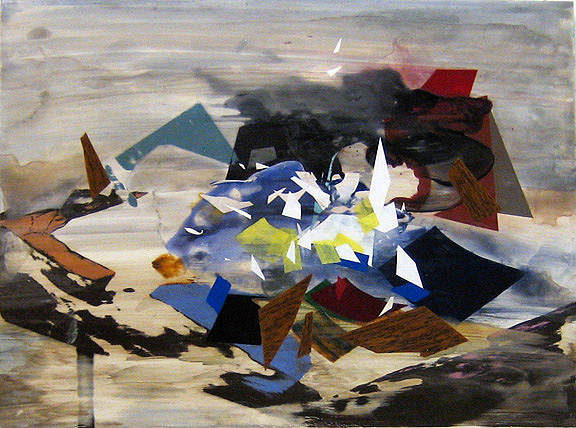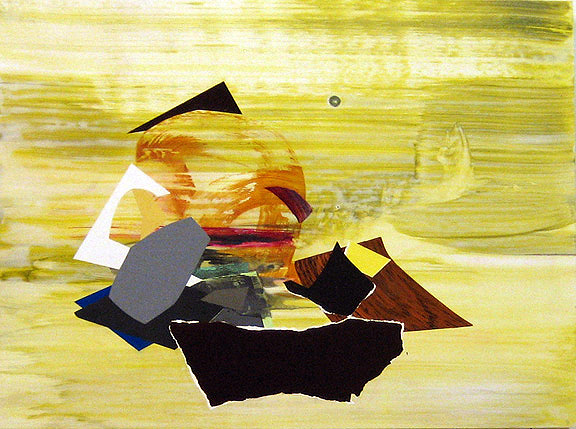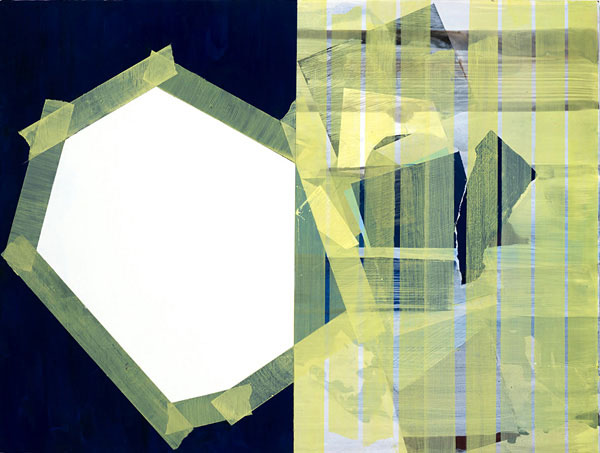Sigrid Sandström in LA.
Swedish painter Sigrid Sandström, 2008 recipient of the John Simon Guggenheim Memorial Foundation and The Joan Mitchell Foundation, is exhibiting in Los Angeles March 14- April 18 at The Company, located in Los Angeles’ Chinatown at 946 Yale Street.
-
 Three of Sigrid Sandström’s works to be exhibited: ‘Untitled.’ Acrylic on Panel, 2009. (18 x 24 Inches)
Three of Sigrid Sandström’s works to be exhibited: ‘Untitled.’ Acrylic on Panel, 2009. (18 x 24 Inches) -
-
More info: www.thecompanyart.com, 213.221.7082 / info@thecompanyart.com
-
 ‘Untitled.’ Acrylic on Panel, 2009. (18 x 24 Inches)
‘Untitled.’ Acrylic on Panel, 2009. (18 x 24 Inches) -
-
Sigrid Sandström
By Olivia Booth
There are many frontal elements in Sigrid Sandström’s work, and I approach it almost as one would a non-rowdy crowd, with angled hips and pardon me’s, amounting to a kind of involuntary folk dance. As with folk dance, it is the complex rhythms and relationships that are the great care here. Sandström is, in a sense, the orchestrator of those rhythms. There is a flexibility about how many can join; joiners seem to keep coming in from the flies, as opposed to laid down frontally, so that even when they freeze in the form of flat frontal colored planes, they carry with them the force of the oblique entrance.
That decoy fluidity appears in many of the paintings in one way or another, often in the form of a grand swoosh that establishes a kind of background.
These fast swoops look like they might be made by squeegees, but how they were made doesn’t matter. The effect is a high speed dynamism that wouldn’t be interesting were they not given strangely low billing despite having lots of room. As I see it, Sandström’s task exploits and undermines this kind of fluidity in order to pull out traction and resistance within it and to marginalize the usual and expected speed and impact. So that the foregrounded (literally and figuratively) forms – the cut, hemmed, sometimes redirected strokes or planes which form a kind of central pile – all help slow down the building speed of the swooshes and pull forth relations between “motions and rests” making velocity a diverse affair, not a simple one, consequently allowing color (especially blue) to exercise its own speeds and dimensions. Fluidity is disarmed and slowness outpaces speed; it’s a triumph of resistance and traction over the windswept.
The images could be said to be whirlwinds (often they look like artic ones), but they are also simply piles of things; I think they come into being less through the idea of representing a whirlwind and more out of the act of piling, phrasing and chunking rhythms and movements. It’s piling as a kind of Earth Art solution to avoid organizing forms, and it’s piling as a way to slow things down (as movements pile up, the piling itself slows the eye down). The whirlwind might be more in the making of the work; I imagine the painter in the constant throws of trying to turn the painting loose and yet maintaining the painting’s looseness, or “under-determinacy” (a word she uses in her statement), and this is the kind of orchestrating which could only be done from inside a whirlwind. It seems as if this underdeterminacy comes from a painter who makes only the marks which she can bear to make, as opposed to ones that she must make (driven by sureness), and in this way I imagine the mark-making comes from doubt and default: dodging certain kinds of moves and marks, always second guessing, editing and hemming the ones she does make so that they are not complete (literally they appear ripped), always moving toward completion and always stalling it. This whirlwind process doesn’t seem to be historically driven, and though default might be a strategy - as in dodging marks that are too familiar or historically wrought or at least cropping and editing them down - hers is not a process of negation. If indeed these works do speak to staking one’s claim in painting, this stake is not necessarily for one’s place in art history or the art world, but rather pitching a place in the already indeterminate dimension of the canvas, where one can do anything but hardly anything will do. In her case to move from this indeterminate place to a highly composed underdeterminate one is a way of staking claim, but not through defiance, negation, assertion or aggression. Hers is an active world arrived at through ultra peaceful means.
I really appreciate that the work doesn’t seem to come with set terms for completion. It’s refreshing that she doesn’t rely on old school abstract painting moments of ‘Aha, now it works,’ or new school abstract painting moments of, ‘There, I’ve sufficiently screwed it up,’ but that finishing a work is just a constant issue/itch as far as I can tell. In the end, perhaps she doesn’t actually turn the painting loose, leaving us to ask what the terms are that mark the end of the dodging and shuffling and orchestrating of rhythms that go into each painting. Or, is there a point when there is nowhere to default to, when she can’t bear any mark any longer? I can’t tell, but I once heard an anecdote about Jasper Johns saying that when one begins a painting, everyone is in the room with them, from Malevich to their grandmother, and as the painting progresses the crowd starts to filter out. This migration carries on as the painter works and thinks, and as the painting is finishing up, the last of them leaves. Then, finally, the painting is done and the painter himself can leave. If in Sandström’s paintings there remain stragglers, I don’t mind at all, the company of peaceful strangers shuffling about fits the spirit of the work. -
 ‘Untitled.’ Acrylic on Panel, 2009. (18 x 24 Inches)
‘Untitled.’ Acrylic on Panel, 2009. (18 x 24 Inches) -
Olivia Booth lives, does art, teaches, and sometimes writes in Los Angeles. Her own paintings look more like sculptures and use planes of glass.
-
-
